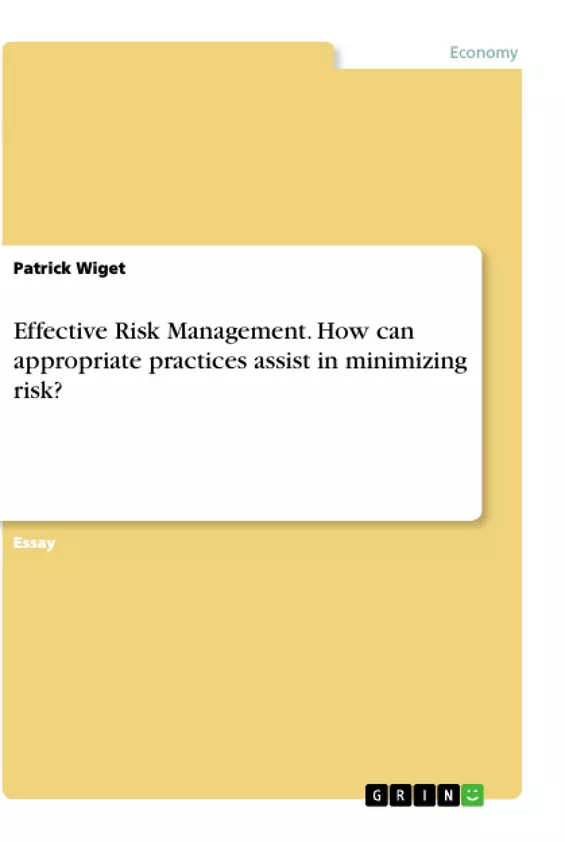This paper will analyze the concept of Risk Management. The main aim lies in discussing how Risk Management can be achieved in the most effective way and additionally, who, in an organization, will take responsibility for an effective management. It will be argued that the question of how responsibility is distributed within an organization is central to the effectivity of Risk Management. How is the risk measured, ranked and outlined by the organization and the management?
The author will outline a possible strategy on how to incorporate a risk management strategy in the form of a visual diagram into a project. Finally, it will be discussed how a professional execution of Risk Management can result in reducing the Risk, its impact on the project and how an effective Risk Management system can be supported and sustained by proper communication throughout the organization
Inhaltsverzeichnis (Table of Contents)
- RISK MANAGEMENT AND DELEGATION OF RESPONSIBILITY
- Effectivity
- The Risk Diagram
- Responsibility
- Measuring & Ranking of Risks
- Outlining of Risk
- CONSTRUCTION OF A STRATEGY FOR PROJECT RISK MANAGEMENT
- Project Description
- Risk Management Strategy used
- Step One: Risk Identification
- Step Two: Risk Analysis
- Step Three: Risk Response Strategy
- Step Four: Risk Monitoring and Control
- Step Five: Communication of Risk Management
- CONCLUSION
- REFERENCES
Zielsetzung und Themenschwerpunkte (Objectives and Key Themes)
This assignment explores the concept of risk management, focusing on its effective implementation within an organization. It delves into the distribution of responsibility for risk management and examines how risks are measured, ranked, and outlined. The paper proposes a visual diagram for incorporating a risk management strategy into a project, showcasing its impact on reducing risks and enhancing project outcomes. It emphasizes the role of communication in supporting and sustaining an effective risk management system.
- Effective implementation of risk management in organizations
- Distribution of responsibility for risk management
- Measuring, ranking, and outlining risks
- Visual representation of risk management strategies
- Impact of risk management on project outcomes and communication in sustaining an effective system
Zusammenfassung der Kapitel (Chapter Summaries)
- Chapter 1: "Risk Management and Delegation of Responsibility" examines the importance of an effective communication system between all stakeholders involved in risk management. It presents a visual diagram illustrating the process of risk management, including the steps of identification, analysis, strategy, monitoring, and communication. This chapter explores the concept of responsibility in risk management, emphasizing the need for a system that addresses all organizational levels and gaining acceptance from stakeholders. It also discusses the significance of clearly outlining risks and the process of measuring and ranking risks.
- Chapter 2: "Construction of a Strategy for Project Risk Management" delves into the practical application of risk management within a project context. This chapter outlines the steps involved in a comprehensive risk management strategy, including identification, analysis, response strategy, monitoring, and control. It emphasizes the importance of clear communication and knowledge transfer throughout the project lifecycle to ensure that all stakeholders are aware of risks and the associated mitigation strategies.
Schlüsselwörter (Keywords)
Key terms and concepts explored in this paper include risk management, effective communication, stakeholder engagement, responsibility, measurement, ranking, outlining, visual diagram, project risk management, strategy, identification, analysis, response, monitoring, control, and communication.
- Quote paper
- Patrick Wiget (Author), 2019, Effective Risk Management. How can appropriate practices assist in minimizing risk?, Munich, GRIN Verlag, https://www.grin.com/document/942882



